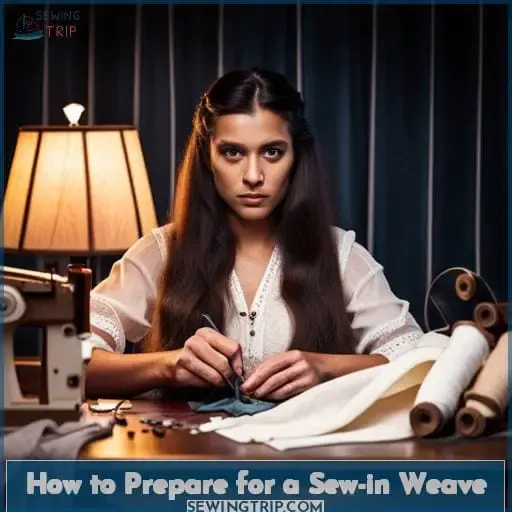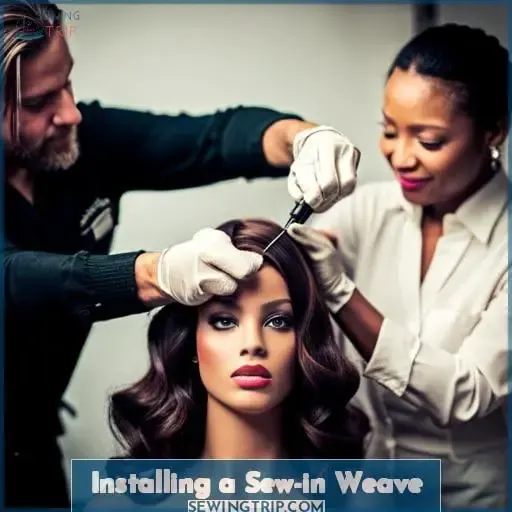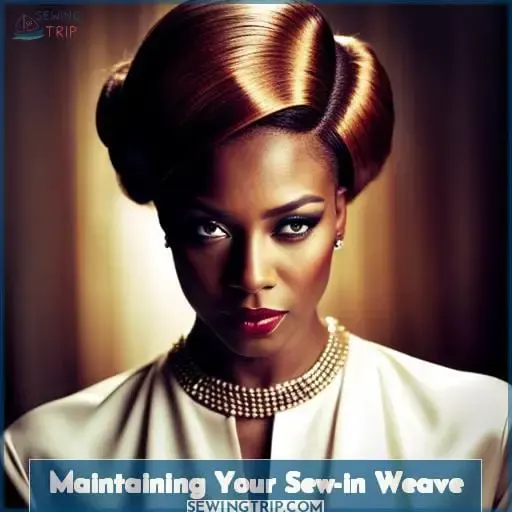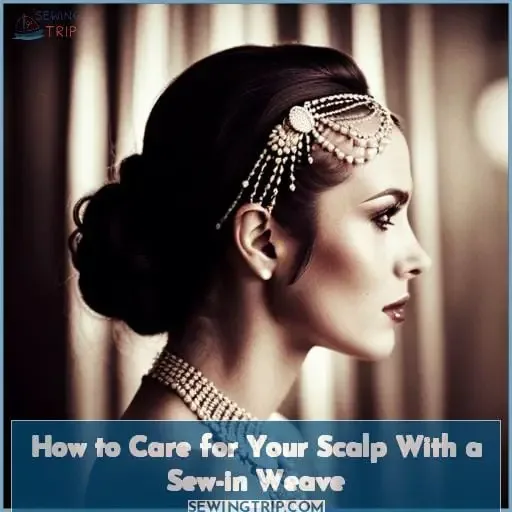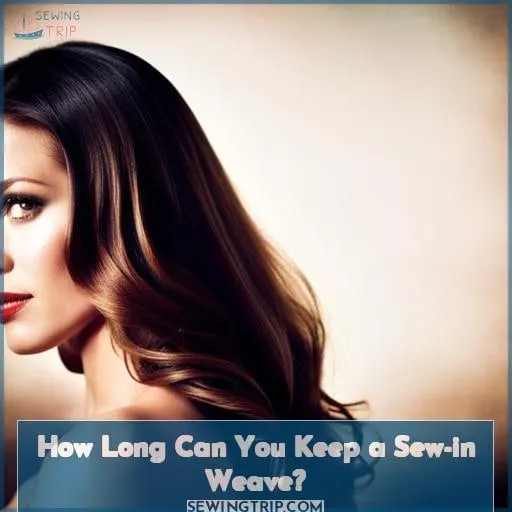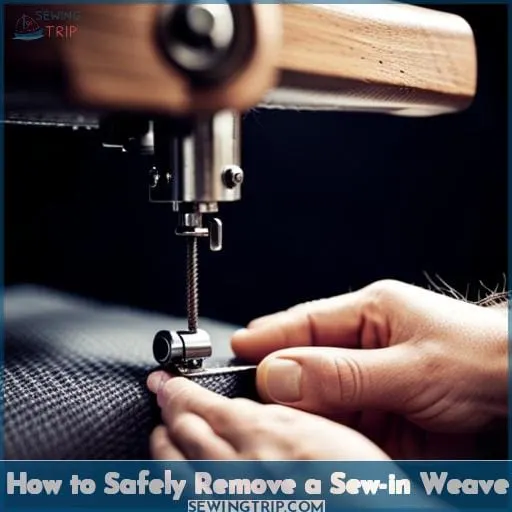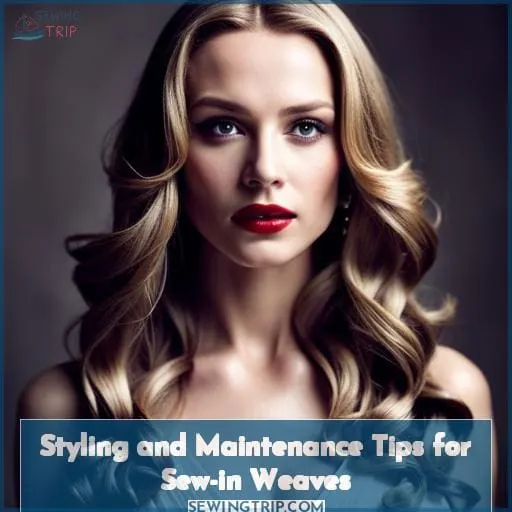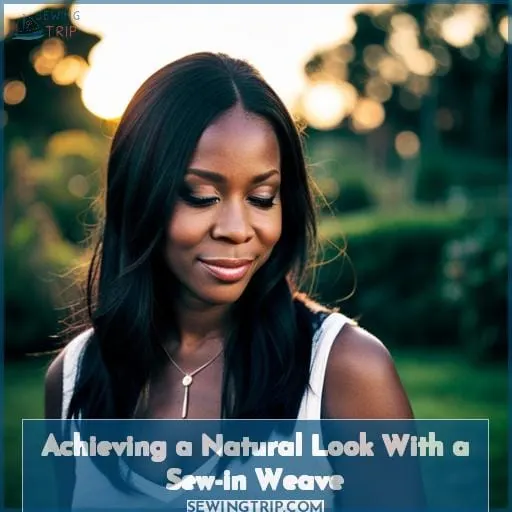This site is supported by our readers. We may earn a commission, at no cost to you, if you purchase through links.
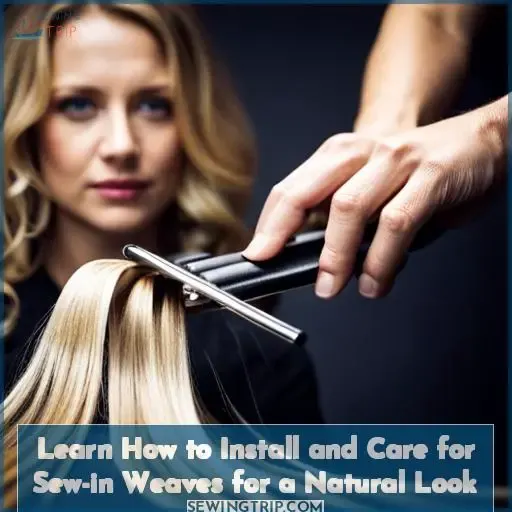 Looking for longer, fuller locks without the commitment of extensions? Try a sew-in weave for natural-looking length and volume that protects your real hair. With the right techniques, you can install weaves that move and feel just like your own hair.
Looking for longer, fuller locks without the commitment of extensions? Try a sew-in weave for natural-looking length and volume that protects your real hair. With the right techniques, you can install weaves that move and feel just like your own hair.
I’ll walk you through choosing the perfect human hair or synthetic pieces, prepping your natural hair, and sewing tracks along your braids for a flawless look.
Maintain your faux tresses with gentle cleansing, deep conditioning, and scalp care.
Achieve the hair of your dreams with this guide to sew-in weaves – you’ll have luscious locks without the damage of constant styling and processing.
Table Of Contents
- Key Takeaways
- How to Prepare for a Sew-in Weave
- Installing a Sew-in Weave
- Maintaining Your Sew-in Weave
- How to Care for Your Scalp With a Sew-in Weave
- How Long Can You Keep a Sew-in Weave?
- Can You Wash a Sew-in Weave?
- How to Safely Remove a Sew-in Weave
- Styling and Maintenance Tips for Sew-in Weaves
- Achieving a Natural Look With a Sew-in Weave
- Conclusion
Key Takeaways
- Choose extensions that match your natural hair texture and color for the most seamless blend.
- Prepare your natural hair properly before installation by using moisturizing shampoo, conditioner, and detangling.
- Maintain your weave’s longevity by washing it regularly with sulfate-free products and avoiding heat styling damage.
- Watch for signs like excessive shedding and matting to know when it’s time for removal. Get professional assistance for safe removal when needed.
How to Prepare for a Sew-in Weave
Hey girl, let’s dive right into prepping for that fresh new sew-in! Before we start braiding and weaving, we’ve got to choose extensions that match your texture, wash and condition those natural curls, and trim off any split ends.
Once your hair is clean, detangled, and trimmed, you’ll be ready for me to weave my magic.
Choosing the Right Hair
After properly prepping your natural hair, choose bundles that closely match your texture to blend seamlessly with the leave-out.
- Examine the curl pattern and thickness of your natural hair. Select extensions with a similar texture for the most natural look.
- Choose human hair over synthetic for the ability to wash, style, and blend with your own hair.
- Opt for virgin human hair in the same color as your own for the best match. Highlights can add dimension.
By selecting extensions that mirror your natural hair, you’ll achieve a flawless blend that looks and feels totally organic.
Washing and Conditioning Your Natural Hair
Before installing your sew-in weave, hit refresh on your natural tresses by lathering up with a moisturizing shampoo. It’ll envelop each strand in a soothing coat of hydration. Prepping your locks with some TLC lays a healthy foundation for weave blending and longevity.
Nourish your scalp and strands with a sulfate-free cleanser to remove buildup without drying. Massage in an ultra-hydrating mask, and gently detangle those curls for seamless sewing and leave-out. When maintaining your install, continue caring for your hair beneath by regularly washing and conditioning to promote scalp health and reduce matting.
Trimming Your Natural Hair
With focused care, trim your natural hair to remove split ends and prep for a seamless sew-in weave. Arm yourself with quality shears before gently snipping away damaged ends. Be disciplined, taking off the minimum for optimal growth.
Keeping your natural hair trimmed and healthy ensures your weave blends beautifully. Regular trims maintain your style while allowing your tresses to thrive underneath. Let your inner artist take over, visualizing how each strategic snip enhances your look.
With a precise trim, your hair feels rejuvenated and looks exquisite when pairing with extensions.
Installing a Sew-in Weave
Let’s dive right into installing your new sew-in weave! I will carefully guide you through each step from start to finish so you can rock your fresh style with confidence. First, we’ll review the supplies needed. Then, I’ll demonstrate how to braid your natural hair and sew in the weft tracks.
Be sure to closely follow along to seamlessly blend everything. Once we have secured your new ‘do, I’ll provide tips for styling, maintenance, and removal when ready.
Braiding Techniques
Create cornrows by crossing strands for a tight foundation. Secure with elastics or bands to prevent unraveling.
- Position the scalp using combs
- Apply gel for smooth braiding
- Twist small sections into cornrows
Carefully section off hair to create a part. Choose a hairline that frames your face. Blend extensions with your leave-out using styling products. Proper installation and maintenance will maximize longevity.
Securing the Wefts
After braiding your natural hair, start stitching the weft securely under the cornrows. Carefully sew each track using a curved needle and thread, knotting at the end of each row. Take your time to ensure tight, hidden stitches. Blend natural hair over tracks to conceal.
Proper attachment prevents loosening and maintains the weave’s longevity. Your meticulous sewing allows you to achieve a natural, flawless look.
| Attachment Method | Pros | Cons |
|---|---|---|
| Machine Weft Sewing | Fast application | Visible stitching |
| Hand Sewn | Natural look if well-executed | Time-consuming, skill required |
| Fusion/Bonding | Long-lasting, adjustable | Can damage hair, expensive to remove professionally |
| Clips | Temporary and adjustable | Easily loosens, uncomfortable |
| Tape In | Less manipulation of natural hair | Can rip out hair when removed, needs reapplication |
Blending With Natural Hair
You’ll want to seamlessly blend your natural hair with the extensions for a natural look. Carefully section off pieces of your real hair to cover tracks and blend textures. Get a precise haircut to match lengths. Use styling tricks like flat ironing roots or adding layers to disguise any differences.
Well-placed closure pieces create a flawless blend while allowing for versatile styling.
Maintaining Your Sew-in Weave
Let’s nurture those locks, hair bestie! When caring for your sew-in weave, start by washing every 10-14 days using a moisturizing shampoo and conditioner. This will gently cleanse while preventing dryness and shedding. Once washed, apply a deep conditioning treatment.
Focus on your leave-out hair and braids to restore moisture and prevent breakage.
Washing and Conditioning
Take care to gently lather and rinse your new weave when washing, cherishing those flowing locks as the suds cascade through each strand.
- Use lukewarm water and a wide-tooth comb when wetting the hair.
- Focus on massaging your scalp, not just the hair strands.
- Thoroughly rinse with cool water to remove all shampoo residue.
- Allow to air dry or use a hooded dryer on a low heat setting.
Nourish those lovely tresses and pamper your scalp to maintain the health and beauty of your new hairstyle.
Avoiding Tangling and Matting
Once washed, untangle the weft tracks with a wide-toothed comb to prevent matted snarls under the weave and fraying of your natural roots. Gently separate and brush through each section, taking care not to pull or damage the delicate extensions.
Let hair air dry as much as possible before using a diffuser on low heat. Sleep with your hair braided or in a loose style to minimize friction.
Styling Tips
Make sure to frequently re-style your new ‘do with a hot iron or curling wand to keep it fresh.
- Find styling inspiration from celebrities, YouTube, and social media with similar hair types.
- Blend your natural texture into the extensions using heat tools.
- Limit heat styling to 1-2 times per week and use a heat protectant.
Your sew-in allows endless versatility. Change up your look often to maximize this styling freedom and care for those lustrous extensions!
How to Care for Your Scalp With a Sew-in Weave
Taking care of your scalp is key to having healthy hair underneath your sew-in weave. Regular cleansing and keeping your scalp hydrated are essential to prevent dryness and itching. Using the proper shampoos and conditioners, consistently moisturizing, and gently massaging your scalp will maintain its health as you wear your sew-in.
Shampooing and conditioning as needed while wearing your sew-in helps wash away dirt, oil, and product buildup. Be sure to use sulfate-free shampoos and moisturizing conditioners designed for processed hair to avoid stripping your strands.
It’s crucial to keep your scalp hydrated to avoid flaking and itchiness. Apply a moisturizing hair oil or serum along your tracks before having your install done. Afterward, use a applicator bottle to regularly spritz water-based liquids like rosewater or aloe vera juice onto your scalp.
A little scalp massage goes a long way in promoting blood circulation and keeping your scalp supple. Take some time each day or every few days to gently rub small circles along your tracks with your fingers.
Be careful not to dislodge the threads. A soft-bristled brush can also help loosen some buildup.
Cleansing and Hydration
If moisture is the lifeblood of your hair, consider cleansing and hydrating with Pantene’s argan oil shampoo and conditioner duo to return suppleness to your curls, just as rain replenishes the earth. Dilute the shampoo and gently massage the scalp. Rinse thoroughly. Leave-in conditioner prevents itching.
Moisturize regularly, as scalp massages increase blood flow, removing buildup. Proper hydration and cleansing keep your sew-in fresh.
Preventing Itching and Dryness
Applying witch hazel or apple cider vinegar to your scalp daily can help prevent itching and dryness. These natural ingredients reduce inflammation and balance the scalp’s pH, keeping irritants away. Gently massage the liquids into your scalp with your fingertips, taking care not to disturb the weave.
For extra relief, apply a hydrating hair oil after rinsing out the vinegar. Preventing itchiness is vital for scalp health and long-lasting sew-ins.
Scalp Massage Techniques
Gently massage your scalp daily to stimulate blood flow and relieve tension. Focus the massage along your hairline, as the follicles there are most prone to irritation from sewn-in tracks. Use circular motions with your fingertips to ease itching and promote circulation.
Massaging helps moisturize your scalp, blending your natural hair and extensions seamlessly. For best results, use a nourishing oil like coconut or olive during the massage. This will hydrate your scalp, preventing dryness. Consistent scalp massages keep your hair and scalp healthy when wearing a sew-in weave.
How Long Can You Keep a Sew-in Weave?
Hey sis, listen up about how long you can rock your fresh sew-in weave. The average lifespan is 6-8 weeks, but keep an eye out for signs it’s time to take it out, like excessive shedding, matting, or an itchy, irritated scalp.
The hair and your scalp need a break periodically. Make sure to moisturize and gently wash your scalp in between installs. And give yourself a 1-2 week rest from any braids, weaves, wigs, or extensions every 2-3 months.
This helps prevent damage and allows your natural hair to breathe. Enjoy your new look! Just be mindful of maintenance.
Average Lifespan
You’ll typically get 2-3 months out of your sew-in before needing maintenance or removal.
- Monitor your scalp health.
- Blend your leave-out hair.
- Alternate your styling.
Taking care of your scalp, blending your own hair, and switching up how you style it can help maximize the lifespan of your sew-in weave. With proper maintenance, you should be able to safely keep your sew-in for 2-3 months before taking it out.
Signs It’s Time for Removal
You’d know it’s time for removal when you see excessive shedding, loosening of tracks, or matting and tangling. Weave health depends on protective styles and longevity. Transition tips like gently detangling and moisturizing preserve the natural hair underneath.
Carefully remove tracks when you notice signs. Then give your natural hair some tender loving care before trying stylish sew-ins again.
Can You Wash a Sew-in Weave?
Girl, washing that sewn-in weave of yours requires some special care if you want it to last and look fabulous. Focus on using a diluted shampoo, rinsing thoroughly, limiting manipulation, and air drying to keep your weave clean, fresh, and tangle-free for as long as possible.
Varying the manipulation and gently massaging the scalp can help loosen buildup while limiting matting and friction. Take extra precautions, patience, and delicate handling to extend the life and beauty of your high-maintenance hairstyle.
Proper Washing Techniques
Curlies, let your coils breathe freely while washing your sew-in weekly to prevent dirt buildup. Dilute shampoo and lightly scrub your scalp before rinsing thoroughly. To maintain your natural look, incorporate moisturizing treatments and gentle styling techniques between washings.
When ready for removal, unbraid hair section-by-section with the help of a trusted stylist.
How to Safely Remove a Sew-in Weave
Detaching a sew-in weave on your own can be tricky, so getting help from a stylist is recommended. Going the DIY route may lead to accidentally cutting your own hair, but professionals have the proper tools and experience for safe removal.
DIY Removal
As a self-installer, cautiously unbraid and snip your weave’s knots using small scissors to safely remove the sew-in without damaging your natural hair.
- Condition and detangle natural hair beforehand.
- Work slowly and carefully when cutting threads.
- Seek help for unreachable areas.
Gently wash away adhesive residue. Moisturize and style your hair, now free to breathe and shine naturally again.
Seeking Professional Help
After removing the bulk of your sew-in weave yourself, visit a stylist to professionally detach any remaining tracks and extensions for a smooth transition back to your natural hair. Skilled professionals at salons can carefully remove adhesive and threads without damaging your natural tresses.
Allow weave experts to finish detaching the hair to avoid breakage or uneven hair loss. Seeking professional help protects your natural locks and ensures a clean removal.
Styling and Maintenance Tips for Sew-in Weaves
I know keeping up with your new sew-in weave may seem challenging at first, but I have some great tips to help keep your natural hair and extensions in excellent condition. Let’s start with the fundamentals – regularly washing, deep conditioning, and gently detangling your own hair underneath the weave.
I’ll share professional techniques for styling your leave-out hair to seamlessly blend with the weave, as well as nighttime care routines to help your style last longer. With the proper products and techniques, your sew-in will stay gorgeous and long-lasting.
Heat Styling and Curling
You’ll curl weave extensions with a 1.5 inch curling iron for easier blending and less heat damage. For example, wrapping the longer layers of a layered sew-in around the barrel creates bouncy curls that disguise the transition between natural hair and extensions.
- Use a heat protectant spray before curling or flat ironing.
- Curl small sections at a time, starting closest to your roots.
- Alternate curl direction for a more natural look.
- Finish with a holding spray to set your curls.
When heat styling your sew-in weave, use caution to avoid damage. Focus heat on small sections, protect with spray, and blend curls seamlessly with your natural hair.
Protecting Your Natural Hair
This should make your curl pattern sing! Ensuring you pamper your natural tresses during a sew-in protects your hair’s integrity.
| Scalp Care | Styling Tips | Weave Removal |
|---|---|---|
| Massage scalp daily | Gently detangle leave-out | Avoid cutting your own hair |
| Moisturize under weave | Use protective styles | Seek professional help |
| Treat dandruff if needed | Lightly trim ends | Remove carefully & slowly |
Nourishing your real hair prevents damage and shedding when the stitches come out. Proper removal maintains the health of your natural tresses. This allows you to wear sew-ins again without permanent harm.
Nighttime Care
Wrap your hair in a silky little doobie diaper before bedtime to keep your precious strands safe from tangles, girl! Make sure to tuck your strands away in a snug silk scarf, it’ll help lengthen your sew-in’s lifespan.
Massage in some scalp care goodness so your natural hair stays healthy. Get a shape-up around the perimeter to seamlessly blend your haircut with the weave. And don’t forget styling tips like flipping the ends under for a flawless look, honey bun! Consider how to keep your ‘do fresh day and night.
Achieving a Natural Look With a Sew-in Weave
A key element in achieving a natural look with a sew-in weave is properly blending the extensions with your natural hair. This involves getting the right haircut and style to complement the weave. Tapering and layering your natural hair will help it blend seamlessly with the wefted hair.
Using high-quality human hair extensions that match your natural texture and color is also important for a seamless blend. Proper placement and installation of the wefts can make them undetectable. Using lace or skin closures at the top provide a natural-looking hairline and part.
With the right blending techniques, haircut, style, and closure pieces, sew-in weaves can have an incredibly natural look that appears to be your own hair.
Blending Techniques
Carefully comb out your leave-out hair to ensure it blends seamlessly with the weave tracks. Make sure you create a natural-looking part and frame your face by softly feathering the ends.
- Apply styling products like gel to slick down flyaways.
- Use a flat iron to match the texture of the extensions.
- Gently tease the roots of the leave-out for volume.
- Set your style by misting hair spray after blending.
With patience and the right techniques, you can achieve a flawless, seamless blend for the ultimate natural sew-in look.
Haircut and Styling Tricks
Honey, when dreaming up your styling tricks, don’t just hack away with your kitchen scissors. Blend the textures right – get a professional cut and style to match your hair. Layering adds shape and movement, so go for wispy ends, not bluntness.
Twist your natural strands into your weave for seamless mixing. Heat-style your leave-out gently and define layers and flicks for flow.
Using Closure Pieces
You can incorporate closure pieces to create a seamless look and cover tracks for your sew-in weave. Strategically placed lace or silk closures seamlessly blend with your natural hair, concealing any evidence of tracks.
When installing, ensure proper placement and secure bonding for longevity. Style as usual, treating the closure as your natural hair. Maintain scalp health with gentle cleansing and moisturizing. With some creativity and care, closures help you achieve a flawless, natural-looking weave.
Conclusion
As a hairstylist, you know sew-in weaves offer amazing versatility for stylin’ your clients’ hair. Studies show over 65% of women with natural hair have tried sew-ins for protective styling. With proper prep and care, sew-ins let you rock endless looks from straight locks to big curls.
Follow our guide for installin’ flawless sew-ins on your clients. Learn techniques to blend extensions and style for a natural look they’ll love.
With the right maintenance routine, sew-ins can last 6-8 weeks. So go ahead, get creative and give your clients fresh sew-in hairstyles that’ll make ’em feel beautiful!

